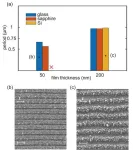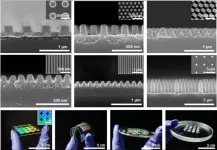(Press-News.org) SAN FRANCISCO, Aug. 16, 2023 — With Labor Day approaching, many people are preparing to go tubing and swimming at local streams and rivers. These delightful summertime activities seem innocuous, but do they have an impact on these waterways? Today, scientists report preliminary results from the first holistic study of this question, which shows that recreation can alter the chemical and microbial fingerprint of streams, but the environmental and health ramifications are not yet known.
The researchers will present their results at the fall meeting of the American Chemical Society (ACS). ACS Fall 2023 is a hybrid meeting being held virtually and in-person Aug. 13–17, and features about 12,000 presentations on a wide range of science topics.
The project stemmed from a conversation between Carsten Prasse, Ph.D., and James Ranville, Ph.D., about the impact of human activities on surface waters. “There's a lot of talk about things like wastewater getting into surface waters,” Prasse says, “but one aspect that hasn't really been thought about is people swimming in surface water — especially in relation to climate change and hotter summers, as water levels drop.”
So, the researchers teamed up to explore the effect of summer fun on freshwater streams. Ranville, who is at Colorado School of Mines, proposed nearby Clear Creek for the study. His group would examine inorganic contaminants, including metals and nanoparticles. Prasse’s team at Johns Hopkins University would evaluate organic contaminants, such as pharmaceuticals. Ranville also enlisted the help of John Spear, Ph.D., at Colorado School of Mines to investigate the microbiome of the stream.
In 2022, the Colorado researchers collected water samples during the busy Labor Day weekend and on a quieter weekday afterward. On many weekends, as many as 500 people per hour use the stream for tubing and swimming at that part of Clear Creek. An undisturbed location upstream was sampled for comparison. The samples were then tested with state-of-the-art analytical approaches, including inductively coupled plasma-mass spectrometry and liquid chromatography-high resolution mass spectrometry. The main goal was to look for changes in chemicals that could be detected in the water.
“We used software and high-level instrumental analysis to piece together a story of what people were doing to the stream,” says Noor Hamdan, a graduate student in Prasse’s lab who will present the work at the meeting. “We found a lot of human metabolites, a lot of pharmaceuticals, some illicit drugs and some sunscreens — really a whole slew of compounds that humans are associated with,” says Hamdan. Those compounds presumably washed off people’s skin or were released in sweat or urine, among other possible sources.
Preliminary results from Prasse’s lab suggested the presence of cocaine, lidocaine (a topical anesthetic), fexofenadine (an antihistamine), lamotrigine (a treatment for seizures and bipolar disorder) and gabapentin (a medication for seizures and nerve pain), as well as polyethylene glycol (used in medications and numerous other applications) and phthalates (plasticizers). Organic sunscreens and UV filters were also detected.
Carmen Villarruel, a grad student in Ranville’s lab, found that human recreation stirred up sediments in the creek, thereby raising the water’s concentration of metals, such as copper, lead, zinc, aluminum and iron. “Much of the metal was in particulate form, which has implications for wildlife,” Villarruel says. For example, these sediments could clog the gills of fish, making it harder for them to absorb oxygen from the water. In addition to the metal particulates, the team found some dissolved metals in the water, which could affect reproduction, species diversity and the health of aquatic species, Ranville notes.
Tubing and swimming also altered the creek’s microbial profile, increasing the abundance of microorganisms commonly associated with human waste. Spear says that could impact species that live in the river, such as fish, as well as microorganisms that occur naturally in the water and are key components of the ecosystem.
The team used Environmental Protection Agency software to run a risk assessment on the compounds in the river. They found that most of the compounds aren’t particularly prone to bioaccumulate, Hamdan says. But the researchers also emphasize that there are no data available on long-term toxicity or persistence in the environment, and there are insufficient data to evaluate exposure risks for a lot of the compounds.
“So that's an important finding from this project,” Hamdan says. “We now know that these compounds are in the river. But we don’t know their concentrations or how they impact the fish or other species in the environment.” In future research on this project, the team plans to collect more samples to track trends over time.
In the meantime, Prasse has some useful advice for people who want to have fun in the water. “Don’t pee in rivers,” he says half-jokingly. “When you urinate into a toilet, the water goes to a wastewater treatment plant before it is discharged into a river. But if you urinate into a river, all those chemicals go directly into the water. We know that things like pharmaceuticals can impact aquatic species, such as fish, even at very low concentrations.” He also recommends using mineral sunscreens, such as zinc oxide, instead of sunscreens that contain UV filters, which can be toxic to aquatic organisms.
The researchers acknowledge support and funding from Johns Hopkins University and the National Science Foundation.
A recorded media briefing on this topic will be posted Wednesday, Aug. 16, by 10 a.m. Eastern time at www.acs.org/acsfall2023briefings. Reporters can request access to media briefings during the embargo period by contacting newsroom@acs.org.
For health and safety information for ACS Fall 2023, please visit the FAQ webpage.
The American Chemical Society (ACS) is a nonprofit organization chartered by the U.S. Congress. ACS’ mission is to advance the broader chemistry enterprise and its practitioners for the benefit of Earth and all its people. The Society is a global leader in promoting excellence in science education and providing access to chemistry-related information and research through its multiple research solutions, peer-reviewed journals, scientific conferences, eBooks and weekly news periodical Chemical & Engineering News. ACS journals are among the most cited, most trusted and most read within the scientific literature; however, ACS itself does not conduct chemical research. As a leader in scientific information solutions, its CAS division partners with global innovators to accelerate breakthroughs by curating, connecting and analyzing the world’s scientific knowledge. ACS’ main offices are in Washington, D.C., and Columbus, Ohio.
To automatically receive press releases from the American Chemical Society, contact newsroom@acs.org.
Note to journalists: Please report that this research was presented at a meeting of the American Chemical Society.
Follow us: Twitter | Facebook | LinkedIn | Instagram
Title
Assessing the impact of recreational activities on a natural stream: a Colorado River case study
Abstract
Water-based recreational activities introduce a substantial amount of human activity to freshwater streams and rivers, specifically during warmer weather. Despite the clear potential for perturbation of freshwater stream conditions, anthropogenic alteration of the chemical fingerprint of natural streams has seen little study. We examined Clear Creek in Golden, Colorado as a test case utilizing state-of-the-art analytical approaches including single-particle ICP-MS and LC-HRMS to determine the chemical changes of inorganic and organic water constituents resulting from recreational activities, primarily float tubing. Changes due to high use were observed through spatial and temporal sampling for three days over Labor Day weekend, where Clear Creek saw a large influx of tubing activity. For the analysis of organic compounds, the samples were extracted using solid-phase extraction and analyzed for organic contaminants using a nontarget approach. The results showcase significant changes in the organic fingerprint of the stream when comparing days and locations that coincided with high or low/no recreational use. High confidence level hits of specific compounds, such as avobenzone, cocaine, lamotrigine, and specific xenobiotic metabolites were also observed. Analysis of inorganic constituents using ICP-MS shows an increase in total suspended solids correlated with suspended particulate metals (Al, Cu, Pb, Ti, Pb, and Zn) in the water column. Element ratios implicated recreation-induced resuspension of streambed sediments as the metal source rather than other direct anthropogenic inputs (i.e., Ti/Zn-containing sunscreens). This study is the first to holistically approach the impact of human activity on a natural stream by simultaneously considering the changes in the organic and inorganic fingerprints. In using this approach, the influences on the stream’s ecosystem could be assessed through the identification of compounds that drive the ecotoxicity and by quantifying any potential hazards resulting from the resuspension of metal-containing sediments.
END
Tubing and swimming change the chemistry and microbiome of streams
2023-08-16
ELSE PRESS RELEASES FROM THIS DATE:
Experiencing pain after a heart attack may predict long-term survival
2023-08-16
Research Highlights:
Experiencing pain – even pain not associated with heart disease – a year after having a heart attack is common, and people who had moderate or extreme pain were more likely to die within the next 8 years compared to adults who did not have any post-heart attack pain.
When recommending treatment and making prognoses for people who have had a heart attack, health care professionals should consider if the patients are experiencing moderate or extreme pain.
Embargoed until 4 a.m. CT/5 a.m. ET Wednesday, Aug. 16, 2023
DALLAS, ...
Racism, poverty, and illiteracy increase the risk of contracting and succumbing to AIDS in Brazil
2023-08-16
Social determinants of health —the social conditions in which people grow up, live and work— can influence the risk of contracting AIDS and the mortality associated with the disease. This is the main conclusion of a new study carried out by the Barcelona Institute for Global Health (ISGlobal), a centre supported by the "la Caixa" Foundation, and published in The Lancet Regional Health.
The research team evaluated a cohort of 28.3 million people, representative of the low-income Brazilian population, based on data collected between 2007 and 2015. This is the largest evaluation of social determinants of health ...
Harnessing big data reveals birds’ coexisting tactics
2023-08-16
Birds likely hold smart insights about coexisting in popular habitats– especially as climate change looms. But tapping into that knowledge has a big hurdle: knowing where and how numerous birds live successfully in vast environments.
In today’s biological research journal Proceedings of the Royal Society B, scientists at Michigan State University (MSU) peeled back layer upon layer of big data to tease out real-life answers that until now have been explored mostly in small-scale experiments.
Sam Ayebare, a PhD candidate from Uganda, has led the work that is the first steps to understanding how so many birds can coexist in the vast Albertine ...
Six strategies could boost NY City housing by 300,000 units over decade
2023-08-16
Six policies aimed boosting residential housing construction in New York City could spark the production of roughly 300,000 additional new housing units over a decade, according to a new RAND Corporation report.
The additional housing units would represent more than a 160% increase over recent annual housing production levels in the city, according to the report.
Researchers say the surge in housing supply likely would lead to increased affordability through greater competition among landlords for tenants in the short term and an increase in naturally occurring ...
The Journal of Scientific Exploration publishes special issue on the Shakespeare authorship question
2023-08-16
In the issue, ten historians and literary scholars present evidence that casts serious doubts about who actually authored the monumental works credited to William Shakespeare. Suggesting that the name is actually a pseudonym for someone else, this position has been endorsed by numerous artists and scholars over the decades ranging from Walt Whitman and Mark Twain to Sigmund Freud, Tyrone Guthrie (founder of Canada’s Stratford Shakespeare Festival) and Mark Rylance founding Artistic Director of the reconstructed Globe Theatre in London.
Tradition credits a businessman from an essentially ...
In-school occupational therapy creates positive education experiences for kids with autism
2023-08-16
Strong parent-school relationships are central to a child’s learning, development, and wellbeing, yet when it comes to children with autism (ASD), it seems positive relationships are few and far between say UniSA researchers.
In Australia, an estimated 200,000 people are autistic, with autism the largest primary disability group served by the NDIS. Globally, about one in 100 children are autistic.
Lead researcher, UniSA’s Dr Kobie Boshoff, says support is urgently needed in schools to support the learning needs of children with ...
Team compares reanalysis datasets with Advanced Himawari Imager measurements over East Asia
2023-08-16
Today’s weather satellites provide scientists with a unique opportunity to evaluate the abilities of various reanalysis datasets to depict multilayer tropospheric water vapor. So a research team undertook a study to assess multilayer water vapor depiction in six representative reanalysis datasets against the measurements from the Advanced Himawari Imager over East Asia. Because water vapor is important in the formation of clouds and precipitation, it is vital for scientists to better understand water vapor and the biases among various datasets.
Their work is published in the journal Advances in Atmospheric Science on July 29, 2023.
Scientists produce reanalysis datasets when ...
Controlling the source of electromagnetic waves enables control of the period of laser-induced periodic surface structures (LIPSS)
2023-08-16
Since the scientists at Bell Labs invented the world’s first transistor in December 1947, a revolution in microelectronics technology has profoundly affected lifestyles worldwide. As electronics get smaller and smaller, it is a challenge to find an easy, fast, and low-cost way to fabricate micro-nano components. Traditional direct writing fabrication methods such as mechanical scribing, focused ion beam etching, electron beam lithography, multiphoton polymerization, and thermal scanning probe etching are inefficient. Although methods such as nanoimprinting, photolithography, plasma etching, and ...
Immigration slowed in COVID-19 pandemic, but migrant jobs not filled by U.S.-born
2023-08-16
A prevailing narrative about immigration is that migrants displace U.S.-born residents in the workforce, but new research from University of California, Davis, economists shows that’s not the case.
The study, published in the Journal of Population Economics, details how the COVID-19 pandemic led to a decrease in immigration to the U.S. and how jobs often filled by migrants were not filled by U.S.-born residents.
“We found that this drop in immigrants corresponded also to a drop in employment in some specific types of occupations, including accommodation ...
Advancing metasurface manufacturing with water-soluble mold
2023-08-16
When will the protruding rear camera on smartphones become obsolete? The implementation of a metasurface, which completely disregards the properties of light, promises to reduce the thickness of a camera lens to 1/10,000 of a conventional lens. However, despite this advancement, challenges still persist due to high production costs and intricate processes. Nonetheless, a recent study unveiled a “mold” that dissolves in water, enhancing the efficiency of the fabrication process.
A collaborative team led by Professor Junsuk Rho from the Department of Mechanical Engineering and the Department ...



